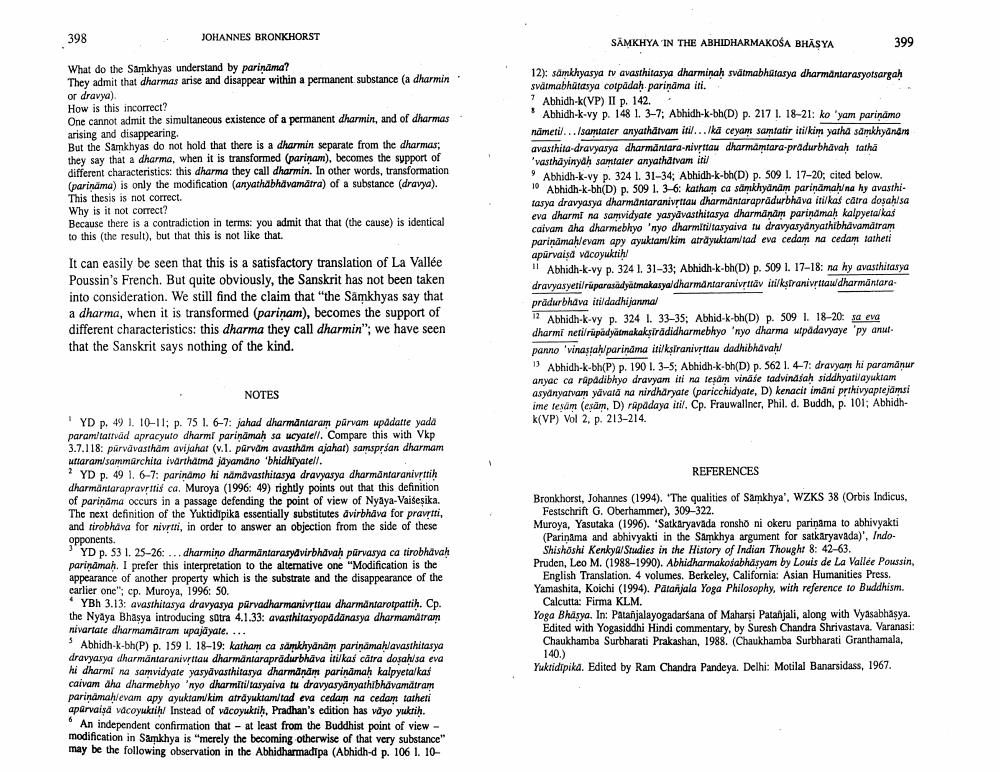Book Title: Samkhya In Abhidharmakosa Bhasya Author(s): Johannes Bronkhorst Publisher: Johannes Bronkhorst View full book textPage 4
________________ 398 JOHANNES BRONKHORST SAMKHYA IN THE ABHIDHARMAKOSA BHÄŞYA 399 What do the Samkhyas understand by parinäma? They admit that dharmas arise and disappear within a permanent substance (a dharmin or dravya). How is this incorrect? One cannot admit the simultaneous existence of a permanent dharmin, and of dharmas arising and disappearing But the Samkhyas do not hold that there is a dharmin separate from the dharmas: they say that a dharma, when it is transformed (parinam), becomes the support of different characteristics: this dharma they call dharmin. In other words, transformation (parinama) is only the modification (anyathabhavamätra) of a substance (dravya). This thesis is not correct. Why is it not correct? Because there is a contradiction in terms: you admit that that the cause) is identical to this the result), but that this is not like that. 12%; samkhyasya iv avasthitasya dharminah satmabhatarya dharmantarasyotsargah svärmabhūtasya cotpadah.parināma iti. Abhidh-k(VP) II p. 142. Abhidh-k-vy p. 148 1. 3-7; Abhidh-k-bh(D) p. 217 I. 18-21: ko 'yam parināmo nāmetil.../samtater anyathavam itil...lkā ceyam samtatir iti/kim yarha samkhyanand avasthita-dravyasya dharmantara-nivstau dharmamtara-pradurbhāvah fatha 'vasthāyinyah samtater anyathatvam iti 9 Abhidh-k-vy p. 324 1. 31-34; Abhidh-k-bh(D) p. 509 I. 17-20; cited below. 10 Abhidh-k-bh(D) p. 509 1. 36: katham ca samkhyanam parinamah/na hy avasthitasya dravyasya dharmantaranivritau dharmantarapradurbhavainilkas citra dosah/sa eva dharml na samvidyate yasyavasthitasya dharmanām parindmah kalpyeta/kas caivam aha dharmebhyo nyo dharmititasyaiva tu dravyasydnyathibhavamatram parinämah/evam apy ayuktam/kim aträyuktanstad eva cedam na cedam latheti apūrvaisd vacoyuktih/ "Abhidh-k-vy p. 324 1. 31-33; Abhidh-k-bh(D) p. 509 1. 17-18: na hy avasthitasya dravyasyetirüparasadyatmakasyaldharmdntaranivritāv iti/kstranittaudharmantaraprădurbhava itildadhijanmal 12 Abhidh-k-vy p. 324 1. 33-35: Abhid-k-bh(D) p. 509 I. 18-20 sa eva dharmi netilrúpadyatmakakşīrādidharmebhyo 'nyo dharma utpadavyaye 'py anul panno 'vinastah/parināma iti/kşiranivttau dadhibhavah/ 13 Abhidh-k-bh(P) p. 190 1.3-5; Abhidh-k-bh(D) p. 562 1. 4-7: drayam hi paramāņur anyac ca rapddibhyo dravyam iti na tesam vindse tadvindsah siddhyatilayuktam asyanyaivam yavata na nirdharyate (paricchidyate, D) kenacit imani prthivyaptejamsi ime lexum (esäm. D) rūpddaya inil. Cp. Frauwallner, Phil. d. Buddh, p. 101; Abhidhk(VP) Vol 2. p. 213-214. It can easily be seen that this is a satisfactory translation of La Vallée Poussin's French. But quite obviously, the Sanskrit has not been taken into consideration. We still find the claim that "the Samkhyas say that a dharma, when it is transformed (parinam), becomes the support of different characteristics: this dharma they call dharmin"; we have seen that the Sanskrit says nothing of the kind. NOTES REFERENCES ! YD p. 49 1. 10-11: p. 75 1. 6-7: jahad dharmantaram pūrvam upadatte yada param tartvad apracyuto dharmi parināmah sa ucyarell. Compare this with Vkp 3.7.118: purvāvasthäm avijahar (v.1. parvam avastham ajahat) samsprśan dharmam uttaram/sammarchita ivarthatma jayamano 'bhidhiyatell. * YD p. 49 1. 6-7: parinamo hi nämavasthitarya dravyasya dharmantaranivetti dharmantarapravstris ca. Muroya (1996: 49) rightly points out that this definition of parināma occurs in a passage defending the point of view of Nyaya-Vaiseşika. The next definition of the Yuktidipika essentially substitutes dvirbhava for pravi, and tirobhava for nivtri, in order to answer an objection from the side of these opponents. YD p. 53 1. 25-26: ... dharmino dharmāntarasydvirbhāvah pūrvasya ca tirobhavah parināmah. I prefer this interpretation to the alternative one "Modification is the appearance of another property which is the substrate and the disappearance of the carlier one", cp. Muroya, 1996: 50. YBh 3.13: avasthitasya dravyasya pūrvadharmanivrttau dharmantarotpattih. Cp. the Nyāya Bhasya introducing sotra 4.1.33: avasthitasyopadanasya dharmandiram nivartate dharmamatram upayate.... Abhidh-k-bh(P) p. 159 1. 18-19: katham ca samkhyanam parinamahlavasthitasya dravyasya dharmäntaranivritau dharmantarapradurbhava itikas cātra dosah/sa eva hi dharmi na samvidyate yasyāvasthitarya dharmanām parināmah kalpyeta/kas caivam dha dharmebhyo 'nyo dharmititasyaiva tu dravyasyanyathibhavamätram parinamahlevam apy ayuktam/kim atrayuktan/tad eva cedam na cedam tatheti aparvaisa vacoyuktih/ Instead of vacoyuktih, Pradhan's edition has vdyo yukrih. An independent confirmation that - at least from the Buddhist point of view - modification in Samkhya is merely the becoming otherwise of that very substance" may be the following observation in the Abhidharmadipa (Abhidh-d p. 106 1. 10 Bronkhorst, Johannes (1994). "The qualities of Samkhya'. WZKS 38 (Orbis Indicus, Festschrift G. Oberhammer), 309-322. Muroya, Yasutaka (1996). 'Satkaryavada ronsho ni okeru parinama to abhivyakti (Parinama and abhivyakti in the Samkhya argument for satkaryavada)'. Indo Shishoshi Kenkya/Studies in the History of Indian Thought 8: 42-63. Pruden, Leo M. (1988-1990). Abhidharmakosabhäsyam by Louis de La Vallée Poussin, English Translation. 4 volumes. Berkeley, California: Asian Humanities Press. Yamashita, Koichi (1994). Patanjala Yoga Philosophy, with reference to Buddhism. Calcutta: Firma KLM. Yoga Bhasya. In: Patañjalayogadarśana of Maharsi Patanjali, along with Vyasabhasya. Edited with Yogasiddhi Hindi commentary, by Suresh Chandra Shrivastava. Varanasi: Chaukhamba Surbharati Prakashan, 1988. (Chaukhamba Surbharati Granthamala, 140.) Yuklidipika. Edited by Ram Chandra Pandeya. Delhi: Motilal Banarsidass, 1967.Page Navigation
1 2 3 4 5
